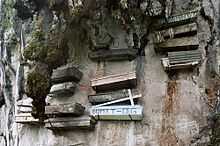Hanging coffins

Hanging coffins are coffins which have been placed on cliffs. They can be found in various locations, including China, Indonesia, and the Philippines. In China, they are known as Xuanguan (simplified Chinese: 悬棺; traditional Chinese: 懸棺; pinyin: Xuánguān) which also means "hanging coffin".
China
Hanging coffins are an ancient funeral custom of some minority groups, especially the Bo people of southern China. Coffins of various shapes were mostly carved from one whole piece of wood. Hanging coffins either lie on beams projecting outward from vertical faces such as mountains, are placed in caves in the face of cliffs, or sit on natural rock projections on mountain faces.
It was said that the hanging coffins could prevent bodies from being taken by beasts and also bless the soul eternally.[1]
Locations of hanging coffins include:
- Fujian
- Hubei
- Jiangxi
- Longhushan (龙虎山), 20 km southwest of Yingtan City (Guyue people)
- Sichuan
- Gongxian County of Yibin, southwest Sichuan (Bo people)
- Qutang Gorge, one of the Three Gorges
- Yunnan
Philippines
Hanging coffins can be found in Sagada, Mountain Province, Luzon Island.
Indonesia
Hanging coffins and funeral effigies of the Sa'dan Toraja people of upland Sulawesi are found in Londa Nanggala cave.
References
- ↑ "The Hanging Coffin". The Hanging Coffin. chinaculture.org. Retrieved 10 October 2011.
- 陆敬严:《中国悬棺研究︰中国悬馆问题的理论与实践》
- 陈明芳:《中国悬棺葬》
External links
China
- Hanging coffins in China
- Mysterious Hanging Coffins of the Bo
- Hanging Coffins a Clue to Ba Mystery
- Hanging coffins in Yunnan
- Mysterious Hanging Coffins of China (documentary)
Philippines
- Sagada Igorot Online - Hanging Coffins
- Hanging Coffins of Sagada
- Picture of hanging coffins in Sagada
- Visit Sagada
- Hanging Coffins of Sagada : A dying Igorot Tradition